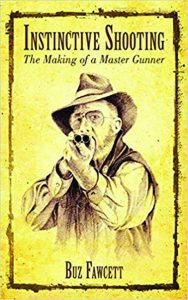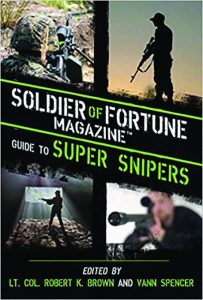Master gunner discusses techniques of shotgun shooting
Review by Larry S, Sterett | Contributing Editor
 INSTINCTIVE SHOOTING: The Making of a Master Gunner, by Buz Fawcett. © 2013. Published by Skyhorse Publishing, 307 West 36h Street, 11th Floor, Dept. TGM, New York, NY 10018. Price: $24.95. Less at Amazon.com. Also available at most bookstores and some gun shops.
INSTINCTIVE SHOOTING: The Making of a Master Gunner, by Buz Fawcett. © 2013. Published by Skyhorse Publishing, 307 West 36h Street, 11th Floor, Dept. TGM, New York, NY 10018. Price: $24.95. Less at Amazon.com. Also available at most bookstores and some gun shops.
This 302-page hardbound volume carries the sub-title The Making of a Master Gunner, and the author’s name should be well known to readers of Sports Afield and Guns & Ammo, publications for which he has served as an associate editor or editor. He has also operated a wing-shooting workshop. (A member of the Fawcett Publications—publishers of Mechanics Illustrated and other such magazines, plus many small booklets, such as Lucian Cary on Guns–family, the author grew up shooting a short-chamber Winchester Model 12 pump gun used by this grandfather as captain of the 1924 Olympic trap team.)
Following a short introduction this tome features 17 chapters, each with numerous black-and-white photographs or sketches. (Some of the photographs are a bit dark, meaning some detail is lost.) There are three useful appendices, but no bibliography or index.
It should not take readers long to note the author is a firm believer in the use of the side/side or double barrel shotgun, which tends to be much less common today in the US than in the UK and Europe. (A century ago the side/side was common in the duck blinds, game fields and even on the trap lines in the US. In fact this shooter in his younger days learned to shoot using an old Remington side/side hammer gun.) The fact the most of the illustrations of shotguns throughout the book are of side/side models, and the heading sketch on the Contents page is of a trim side/side with splinter forearm and straight grip buttstock should cinch the fact. If not, in Chapter 11, Selecting A Shotgun, the following statement appears: THE SIDE-BY-SIDE SHOTGUN, IN THE HANDS OF A SHOOTER WHO UNDERSTANDS IT, CAN AND WILL PERFORM AS WELL OR BETTER THAN ANY OTHER ACTON TYPE OF SHOTGUN.
A couple of decades plus back in time this reviewer visited the Holland & Holland shooting school in the UK. The first stop, after selecting a shotgun, was the patterning boards—steel plates painted with white lead paint. It would have been good to have been able to have read this book prior to that visit, but of course this was not possible. Said book will not make a shotgunner, but it will definitely help, as it covers in detail about everything a shooter needs to do to become a master shotgunner. From eyes to clothing, selection of a shotgun, mounting, tracking, equipment, carrying, pointing, and of course gun care—cleaning and maintenance—is covered.
This is an excellent book for the shooter who wants to become a better shotgunner. For younger shooters it’s a must read, and for older shooters it may help to correct some mistakes, and put more game in the bag. The addition of an index would be nice, but the chapters are relatively short and the chapter title provides an idea of the contents following.
Small book covers WWI combat arms
Review by Larry S. Sterett | Contributing Editor
FIRST WORLD WAR WEAPONS by Scot Addington. Published by The History Press, Dept. TGM, The Mill, Brimscombe Port, Stroud, Gloucestershire, GL5 2QG, UK. Price: 5 pounds. Available in some bookstores, but may be difficult to find. Try Amazon books.
This small quarter-inch thick 128-page softbound book has a sub-title of 5 Minute History on both the front and back covers. Exactly what this means is unclear, as you cannot read the book in five minutes and do it justice, even if you are a speed-reader.
The introduction explains that not every weapon used in WWI is covered, but only those which had the most impact. (Some 35 million casualties were caused, of which an estimated 14 million resulted in death.) Following the introduction this tome is divided into eighteen brief chapters, plus a page-and one-half of notes—really more of a short bibliography.
Beginning with Artillery and finishing with Allied Submarines, the topics covered include Pistols, Machine Guns, Airships, Gas, Grenades, Tanks, and German U-Boats. There are no photographs, but at least one shadow-style outline appears in each three or four-page chapter, plus a sidebar or two.
The sidebars are of two types—a brief Did You Know? Consisting of some obscure war-related fact, and I Was There consisting of brief comments by veterans, generally on some unusual event. Both types of sidebars add to the value of this small book. This reviewer was not aware of the majority of the facts presented in the Did You Know?, This is an interesting pocket-size book on the major world event of 100 years ago. Readers may not agree with some of the author’s comments, such as the chapter on Pistols. It would be better titled Handguns since more countries used revolvers in WWI than they did pistols.
Authoritative book on sniping covers shooters and techniques
Review by Larry S, Sterett | Contributing Editor
 SOLDIER OF FORTUNE MAGAZINE GUIDE TO SUPER SNIPERS, edited by Lt. Col. Robert K. Brown, USAR (Ret.) and Vann Spencer. Published by Skyhorse Publishing, 307 West 36th Street, 11th Floor, Dept. TGM, New York, NY 10018. Price: $24.95, plus shipping. Available at most bookstores and online book sellers.
SOLDIER OF FORTUNE MAGAZINE GUIDE TO SUPER SNIPERS, edited by Lt. Col. Robert K. Brown, USAR (Ret.) and Vann Spencer. Published by Skyhorse Publishing, 307 West 36th Street, 11th Floor, Dept. TGM, New York, NY 10018. Price: $24.95, plus shipping. Available at most bookstores and online book sellers.
Snipers have been around since firearms were invented, and possibly even before in bow and arrow days. In US history there were a few snipers or sharpshooters in the Revolutionary and Civil Wars, and maybe the 1812 War, but World War II saw a major increase in the practice. Thus it is fitting this 346-page hardbound volume is dedicated to all snipers.
Following an introduction by Lt. Col. Brown this well-illustrated book is divided into four sections. The first two sections cover the yesterday’s snipers—mainly WWII, Korea, and Vietnam—plus Afghanistan and Iraq. Section three is devoted to snipers on other fields including Burma, Israel, and Around the World, while Section Four is dedicated to General Sniping. This final section covers basic sniper training and the gear and weapons being used at the time the book was assembled. (So many firms in the US are working on new rifle designs, cartridges, and sound suppressors, current gear is almost outdated before a book on the subject can be published.)
The more than 40 different articles were written by a number of different authors, including the late Chris Kyle, John Plaster, and Lt. Col. Brown. Who is ranked as the greatest sniper of all time? It depends on your evaluation—number killed, most important kills, longest killing shot, etc. The US has had some great snipers, as have some other countries. For total sniper kills it would be difficult to beat the record of Simo Hayhe of Finland with a tally of 542 dead Russians to his credit prior to being wounded by a Soviet sniper on March 6, 1940. Hayhe stood five feet three inches tall, was an excellent skier and woodsman. His shots seldom exceeded 200 meters and often as close as 50 meters. On the close shots he used a Finnish 9mm Soumi submachine gun and on the longer shots a Finnish M28/30 bolt action rifle with open sights. (The M28/30 rifle was a high-quality Finnish version of the Soviet M91/30 rifle and used the same cartridges—7.62x54mm Mosin-Nagant.) Hayhe preferred to use iron sights for a couple of reasons: the ranges were short and the use of a telescopic sight would raise his profile and make him easier to detect, even in his white bedsheet smock. It would be difficult to argue his logic since his average daily kill was five Soviets over a three-month period, with one really good day with twenty-five kills.
This tome is well illustrated with both black-and-white and color photographs. There isn’t an illustration on every page, but there are enough, many of them of snipers with their rifles practicing at the range. It will be noted the use of suppressors on sniping rifles is fairly common, as it permits more shots from a hide without giving the location away. Shots at long range—600 to 1,000 meters—are such that sound doesn’t seem to matter as much as with shorter range shots.
In the World War II chapter no mention is made of the female Russian snipers who accounted for so many dead Germans. However, in a later section by Lt. Col. Mickey Hartman (Ret.) on Israel, mention is made that in the IDF (Israeli Defense Force) woman make better instructors than men and that about 50 percent of the marksmanship instructors are women. (“Without the women instructors, the IDF would shoot less accurately…When a beautiful young woman enters a firing range, the infantry guys shut up and do everything she says without questions; it just works better.”)
This is a most readable book on sniping, from World War II to the present. If you are interested in the subject, this tome deserves space on your reference shelf. The articles are usually brief, and several can be read at a sitting. The caliber of the sniping rifles discussed ranges from the 7.62mm x 51mm to the .50 BMG, and includes the .338 Lapua (8.6x70mm) Magnum or .338 ULR. A few other calibers have been used, but .30 caliber seems to be the smallest suitable caliber for sniping use, especially for ranges beyond a few hundred meters. Rifles used vary, depending on the nation, but the majority are bolt action designs, with only a few semi-automatics, such as the M14 or a variant thereof.
Dog reminiscences by famous authors
Review by Larry S. Sterett | Contributing Editor
OLD DOGS REMEMBERED, Edited by Bud Jones. ©1999. Published by Synergistic Press, 3965 Sacramento Street, Dept. TGM, San Francisco, CA 94118. Price: $12.95, plus shipping. It should be available at Amazon, or possibly some bookstores.
This 240-page softbound volume is not a new book, but it has been reprinted at least once since the first hardbound edition was published by Carroll & Graf. Nor is this book a gun book, although a number of the dogs covered were hunting dogs, including retrievers, setters, and pointers.
A number of the more than 40 stories are by known names—Lord Bon, William Wordsworth, John Updike, James Thurber, T. S. Elliot, and Eugene O’Neill. The remainder are by dog owners we have never heard of, but whose loss can be felt, especially if you have owned and lost a faithful dog companion.
The stories vary in length from one page to several, and there is even an interesting eleven-page section titled Epitaphs and Such, some of which are in the form of poems, including the first one by Sir William Watson, and the final one by Thomas Blacklock.
If you have ever owned a dog, or wanted to own a dog you should enjoy this volume.



